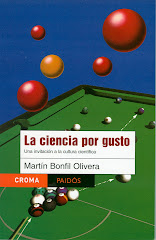Published in Milenio Diario, October 21th, 2009
 Last week we talked about the Chemistry Nobel prize, awarded for the solving of the structure of the ribosome, the cell's protein factory. Today let's talk about Cotija cheese.
Last week we talked about the Chemistry Nobel prize, awarded for the solving of the structure of the ribosome, the cell's protein factory. Today let's talk about Cotija cheese.
There's a link. Bear with me: an investigator from the Chemistry School at the National Autonomous University of Mexico (UNAM), Dr. Maricarmen Quirasco, and her master's-degree student Alma Berenice Zúñiga, have just won the National Award for Food Science and Technology, given by Coca-Cola and the National Council for Science and Technology (Conacyt), a study in which they identify and characterize the main microorganisms that live in the Cotija cheese.
Microbes in a cheese? If you're a fan of this appreciated cheese, which has been hand-produced for 450 years by about 200 families in the Jalmich mountains, close to Cotija, Michoacán, you could worry about this. Don't. The study by Quirasco and Zúñiga seeks a better understanding of the manufacturing process of this aromatic and nutritive cheese (in another study, the same group discovered it has healthy antioxidant properties), in order to protect it and improve it.
The thing is, the production of almost any cheese needs the so called lactic bacteria, which turn milk sugar (lactose) into lactic acid. This increases acidity and causes the milk proteins to curdle, thus transforming into cheese. Many other dairy products, such as yoghurt, are also teeming with microorganisms.
 But in the manufacturing of the Cotija cheese, made with non-pasteurized milk, there's an actual microscopic ecosystem living there, in which there is competition between species and survival . To study it, Quirasco and Zúñiga used modern molecular techniques: they studied the ribosomal RNA genes –the main component of ribosomes, here's the link– from bacteria. These genes are used to identify species because all cells have ribosomes; when comparing them, their differences are detected and make it possible to identify them.
But in the manufacturing of the Cotija cheese, made with non-pasteurized milk, there's an actual microscopic ecosystem living there, in which there is competition between species and survival . To study it, Quirasco and Zúñiga used modern molecular techniques: they studied the ribosomal RNA genes –the main component of ribosomes, here's the link– from bacteria. These genes are used to identify species because all cells have ribosomes; when comparing them, their differences are detected and make it possible to identify them.
The study revealed that, during the ripening process of the cheese, which takes from three months to one year, the competition wipes out all possible pathogen bacteria, which guarantees the cheese's hygiene. And the knowledge gainwill allow, in the future, to standardize the production process and to help manufacturers obtain the "denomination of origin" (Protected Geographical Status), with which they could fight unfair competition from "Cotija type" cheeses, some of them even coming from abroad, that are supplanting the original.
In other words: first-class food science, done at UNAM, that will benefit Mexican producers.
(By the way, you are not necesarily interested in this, but Maricarmen Quirasco and yours truly were together when studying pharmaco-biological chemistry at UNAM, and I admired her great intelligence and dedication to work since the time we studied at National High School number 6. Honestly, congratulations Maricarmen! Read her article of the Cotija cheese, here)
(translated by Adrián Robles Benavides) To receive Science for pleasure weekly
in your email, subscribe here!




No comments:
Post a Comment